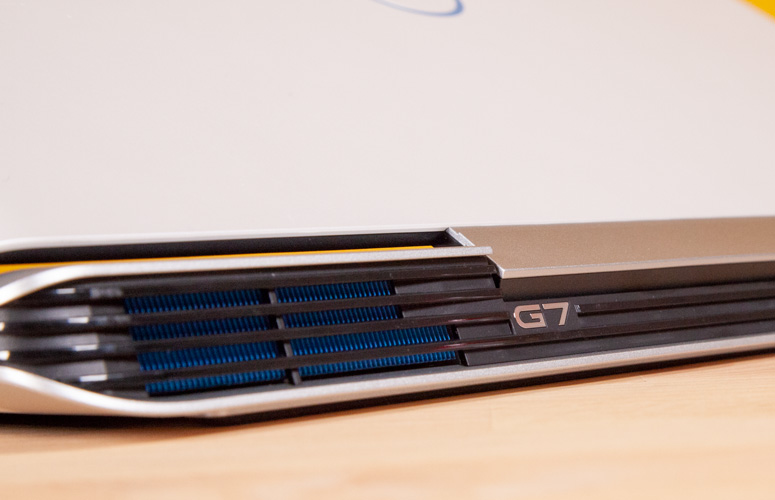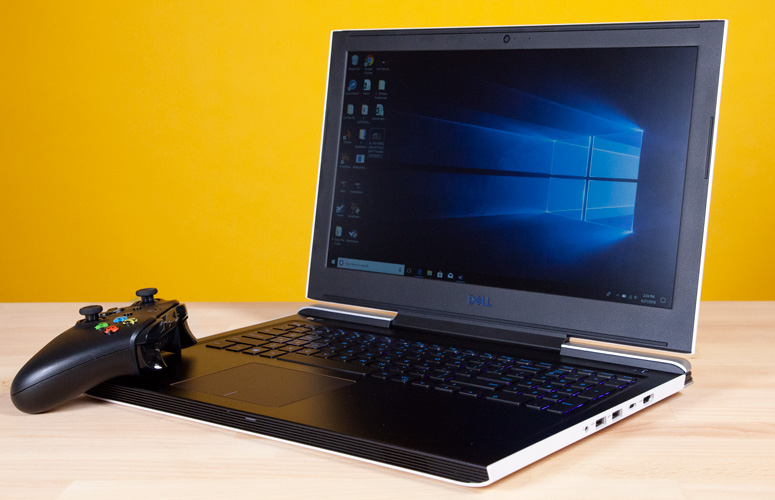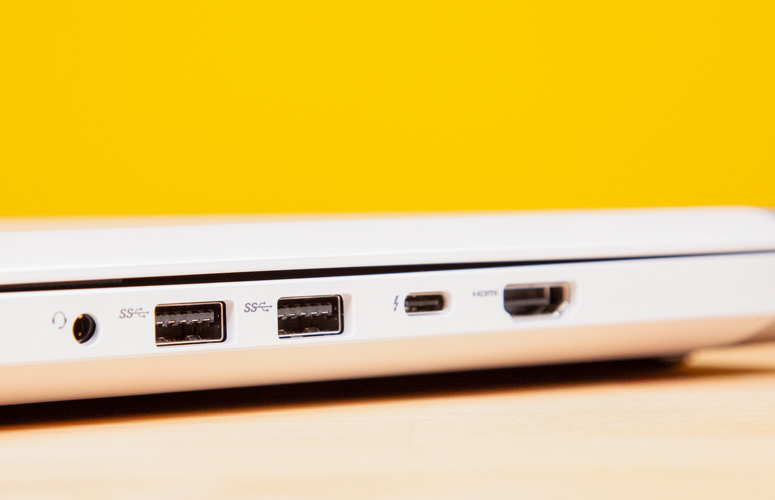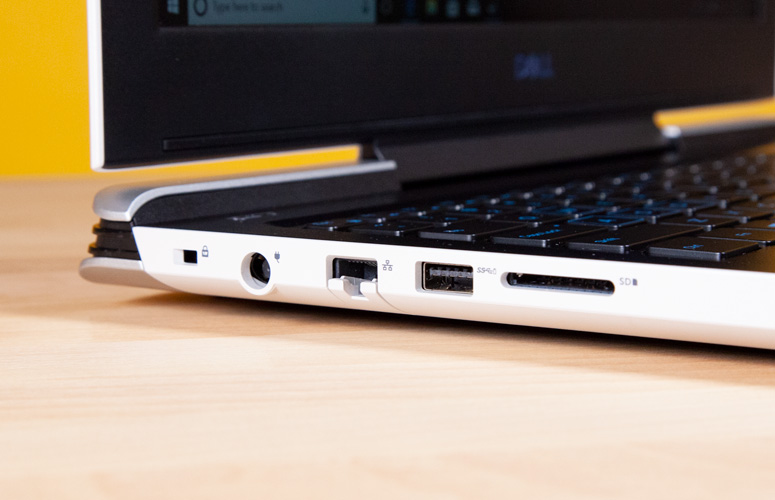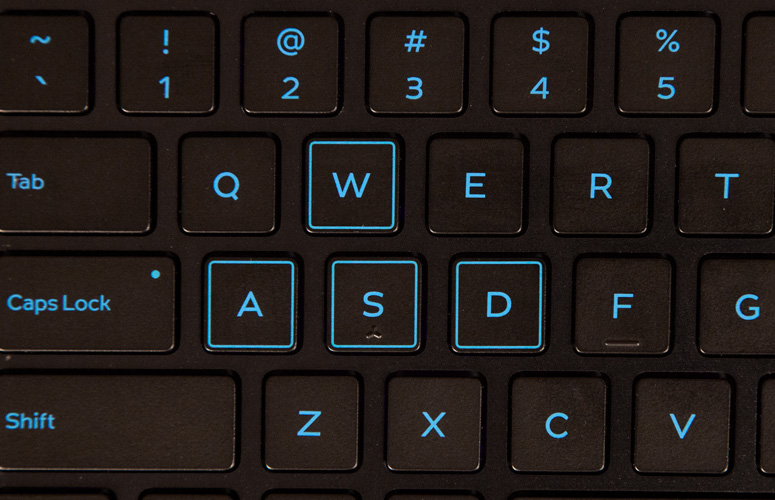Laptop Mag Verdict
The Dell G7 15 delivers strong gaming performance for a budget gaming laptop and has a slick design, but the display doesn't pop.
Pros
- +
Strong overall and gaming performance
- +
Striking design
- +
Good battery life
Cons
- -
Dim display
- -
Shallow keyboard
Why you can trust Laptop Mag
Within every goodbye lies the potential for a promising hello. That's the story with Dell's Inspiron Gaming line. The company recently phased out its entry-level gaming-laptop series in favor of something more exciting and powerful, the new G Series brand, including the G7 15 (starting at $849, reviewed at $1,049).
Rocking a sports-car-like design complete with eye-catching color, the G7 looks like nothing Dell's ever made. But beyond the fetching new look, you get loud audio and specs capable of delivering solid midlevel gaming performance. A dim display and sluggish hard drive keep the G7 15 from landing on our best gaming laptops page. However, that doesn't preclude it from our top cheap gaming laptops under $1,000 page as it has a lot of power for an affordable price.
Design
Not an Inspiron, but nowhere near an Alienware, the G7 has a look all its own that's a breath of fresh air in a sea of black-and-red chassis.
The Alpine White plastic lid with the light-gray hinge is a definite crowd-pleaser. The paint job has a subtle pearlescence that helps to bring out the bright blue Dell emblem in the center.
The rear vent, with its blue highlighting and chrome G7, gives you the sensation that the laptop is about to go racing down the track. A pair of raised, black rubber feet along the bottom allows the hot air to escape.
It would have been nice if Dell had brought that winter white to the system's interior, especially with the blue font on the keyboard. Still, I enjoyed resting my wrists and palms against the cool, black aluminum surface. The bezels surrounding the 15.6-inch display are on the thick side, but I like the shiny Dell logo embedded into the bottom border.
Sign up to receive The Snapshot, a free special dispatch from Laptop Mag, in your inbox.
The G7 has a look all its own that's a breath of fresh air in a sea of black-and-red chassis.
At 6.3 pounds, the 15.3 x 10.8 x 0.9-inch G7 is on the heavier side of the spectrum. However, it's slimmer than its competition, including the PowerSpec 1510 (6.5 pounds, 15.3 x 10.8 x 1.3 inches), Acer Predator Helios 300 (5.5 pounds, 15.4 x 10.5 x 1.5 inches) and MSI GV62 8RE (4.9 pounds, 15.1 x 10.2 x 1.1 inches).
Ports
The G7 is not bursting with ports, but it definitely has enough slots, jacks and inputs to support a modest gaming battle station.
On the right, you'll find two USB 3.1 ports, a Thunderbolt 3 port, HDMI 2.0 and a headset jack.
There's an additional USB 3.1 port on the left alongside an Ethernet port, a 2-in-1 card reader, a Noble lock slot and the power jack.
Display
If only the G7's 15.6-inch, 1920 x 1080 display were as vibrant and brilliant as the laptop's lid. Where Geralt's bone-white hair usually pops against a jet-black sky in The Witcher 3: Wild Hunt, those ashen tresses looked rather listless on the G7. And while I could see the sickly pink, glistening skin of the botchling, it took on a ruddy shade of red that concealed some of the bluish veins underneath.
Watching The Hate U Give trailer, details were so sharp that I could see the stitching and mesh in Starr Carter's Jordans although the red was a little darker than expected. The hue was also off at the red light party which made it look like a magenta gathering instead.
We were disappointed to discover that the panel could reproduce 62 percent of the sRGB color gamut, which is well below the 106 percent average for mainstream gaming laptops. The GV62 and Helios did somewhat better, at 72 and 81 percent. The PowerSpec fared the best, with 113 percent.
If only the G7's 15.6-inch, 1920 x 1080 display were as vibrant and brilliant as the laptop's lid.
The G7's screen also floundered on the brightness test, averaging 232 nits. That's well short of the 296-nit average for mainstream gaming laptops. The Helios shined brighter, at 226 nits, as did the GV62 and PowerSpec, at 240 and 306 nits.
If you want a better screen on this system, we recommend upgrading to a configuration with a 4K display, a version that starts at $1,399.
Audio
The G7's pair of front-firing speakers is surprisingly potent for the price. These speakers filled my bedroom with the seductive tone of Kevin Ross' "Don't Go." Clear wind chimes and sharp percussion accompanied the rich tenor. The keyboard and horns were a little bloated, but I was able to clean it up a bit using the Waves MaxxAudio Pro software by turning on the R&B preset.
When I resumed my search for the Bloody Baron's wife and daughter in The Witcher 3, my horse's hoofs beat a steady gait upon the dirt road. I happened upon a burning barn and heard clearly the crackle and pops of the wooden structure being immolated while an alarm bell clanged in the background.
Keyboard and Touchpad
While I enjoy the G7's island-style keyboard's blue font and brilliant cerulean backlighting, the typing experience leaves something to be desired.
With a shallow 0.94 millimeters of key travel (1.5mm is our accepted minimum) and a decent 61 grams of actuation (our minimum is 60g), the keyboard made typing a bit uncomfortable.
I found myself bottoming out sooner than expected, which made maintaining a good typing rhythm difficult. I managed only 56 words per minute on the 10fastfingers typing test, well below my usual 70 wpm.
The 4.1 x 3.1-inch touchpad delivered better performance than the keyboard, quickly registering multitouch gestures, such as pinch-zoom, three-finger press and flick. The bottom edges of the touchpad produced a nice click when depressed.
Graphics, Gaming and VR
Armed with an Nvidia GeForce GTX 1060 Max-Q GPU with 6GB of VRAM, the G7 is more than capable of playing games on high settings. However, you probably won't get the frame rates that you'd get with a full-fledged 1060 graphics card.
I cast Yrden, the trap spell, to force a gang of wrathful wraith to take corporeal form. When they did, I unleashed a volley of quick attacks with my silver sword, turning my foes to dust at 53 fps and 1920 x 1080 on Ultra settings.
During the Rise of the Tomb Raider benchmark, the laptop notched 35 fps, narrowly beating the 32-fps mainstream gaming average. The GV62 and its full 1060 GPU did slightly better, with 36 fps, while the Helios (GTX 1060) and PowerSpec (Nvidia GTX 1070 GPU) obtained 67 and 56 fps, respectively.
The G7 did better on the Hitman test, achieving 63 fps, which is a couple of frames short of the 65-fps average. That score was on a par with those from the Helios (64 fps), PowerSpec (60 fps) and GV62 (51 fps).
On the Grand Theft Auto V benchmark, the G7 hit 45 fps, which is below the 52-fps category average. The PowerSpec achieved 60 fps, while the Helios and GV62 notched 49 and 48 fps. When we ran the Middle-Earth: Shadow of War test, the G7 achieved 67 fps, topping the 60-fps average.
Armed with an Nvidia GeForce GTX 1060 Max-Q GPU, the G7 is more than capable of playing games on high settings.
In case you're wondering, Max-Q graphics cards can support virtual reality. The G7 delivered 6.3 out of 11 on the SteamVR performance test, topping the 5.6 average. The GV62 and Helios produced 7.3 and 7.1, while the PowerSpec maxed out the test.
Overall Performance
The G7's 2.2-GHz Core i7-8750H processor with 16GB of RAM can hold its own as a multitasker. I streamed an episode of Glow Season 2 on Netflix while running a couple of Twitch streams on Google Chrome with 12 more open tabs, some of which ran Slack, TweetDeck and YouTube, with Windows Defender running a full-system scan.
The G7 continued to impress on Geekbench 4, an overall performance test in which the system hit 19,516, topping the 16,695 mainstream gaming average. The GV62, with its Intel Core i5-8300H, scored 13,689, while the PowerSpec and Helios, with their last-gen Core i7-7700HQ chips, posted marks of 14,223 and 13,587.
On the Excel test, the G7 took only 41 seconds to match 65,000 pairs of names and addresses, beating the 0:46 average. The GV62 and PowerSpec completed the task at 0:59 and 1:08, respectively.
The G7 is saddled with a 1TB and 5,400-rpm hard drive, which is big on storage but rather slow. The system took 50 seconds to duplicate 4.97GB of multimedia files, for a transfer rate of 101.8 megabytes per second. That's below the 291.5-MBps average along with the 124 MBps from the GV62 (128GB M.2 SSD), the Helios' 188.5 MBps (256GB M.2 SSD) and the PowerSpec's 391.5 MBps (256GB NVMe SSD).
During the HandBrake test, the G7 took 10 minutes and 40 seconds to transcode a 4K video to 1080p, a faster result than the 12:01 average. The Dell also outpaced the GV62 and PowerSpec, which clocked in at 13:09 and 14:00.
Battery Life
When it comes to battery life, Dell and Alienware offer some of the best results for gaming laptops. The G7 is no exception, as this system lasted 5 hours and 37 minutes on the Laptop Mag battery test, which consists of continuous web surfing over Wi-Fi at 150 nits of brightness. That time was enough to surpass the 3:48 mainstream gaming average as well as the PowerSpec's 4 hours and the GV62's 2:05. However, the Helios outlasted everything else, with a time of 6:01.
Heat
I spent 15 minutes fending off a wraith in an attempt to transform a botchling into a lubberkin in Witcher 3. After the elapsed time, I measured key points on the laptop for heat. The touchpad measured 80 degrees Fahrenheit, which is below our 95-degree comfort threshold. The center of the keyboard was warmer, at 92 degrees, while the undercarriage measured 112 degrees. Thanks to the plastic panel, my lap didn't feel uncomfortably warm.
Once everything cooled down, we ran the test again, only this time, we had the laptop play a full-screen 1080p video. The touchpad, middle of the keyboard and bottom measured 78, 90 and 93 degrees, respectively.
Webcam
The G7's 720p integrated webcam is passable in a pinch. It's rife with visual noise and somewhat-accurate color, so I wouldn't recommend using this camera for livestreaming, but it'll be fine for a video chat or two. The camera did a good job of capturing the reddish orange in my dress, but the light green took on a grayish pall. At least I could make out the fuzzy ringlets in my hair.
Software and Warranty
Dell should follow the lead of its sister brand, Alienware, and keep the bloatware to a minimum. Thanks to Windows 10, you have links for games like Candy Crush Soda Saga, Candy Crush Saga, Cooking Fever, Bubble Witch Saga and Hidden City: Hidden Object Adventure taking up space. There's also a link for Netflix and an offer to get 20GB of free Dropbox for a year, which is the most useful of the bunch.
The Dell-branded software is a bit more functional. For instance, you have Power Manager, which you can use to check on and maintain the notebook's battery health. Mobile Connect allows you to access your smartphone (including mobile apps) from the PC and vice versa, while Help & Support is a repository of common laptop questions and problems, with topics like navigating Windows and setting up and personalizing your laptop.
Gaming-centric apps include Killer Control Center, which allows you to set network bandwidth priorities for your games and keep a tab on performance. There's also Nvidia GeForce Experience, which offers a suite of utilities designed to enhance your gaming experience, like Battery Boost and Game Optimization.
The Dell G7 15 ships with a one-year limited warranty with mail-in service. See how Dell fared in our Tech Support Showdown, Best and Worst Brands, and Best and Worst Gaming Brands ranking.
Configurations
I took the $1,049 version of the Dell G7 for a spin. It has a 2.2-GHz Core i7-8750H processor with 16GB of RAM, a 1TB 5,400-rpm hard drive and an Nvidia GeForce GTX 1060 Max-Q GPU with 6GB of VRAM.
The $849 base model has a 2.3-GHz Intel Core i5-8300H CPU, 8GB of RAM, a 1TB 5,400-rpm hard drive and an Nvidia GeForce GTX 1050 GPU with 4GB of VRAM.
Not enough power? Then you'll want to take a gander at the $1,599 iteration, which features an overclockable 2.9-GHz Intel Core i9-8950 CPU, 16GB of RAM, a 128GB SSD with a 1TB 5,400-rpm hard drive and an Nvidia GeForce GTX 1060 Max-Q GPU with 6GB of VRAM.
If you want a screen upgrade, you can get a 4K panel with the $1,399 model, which has the same specs as my review unit but adds a 128GB SSD to the mix.
Bottom Line
Dell's G Series notebook is an emphatic step toward the future that maintains a few good lessons from the past. Visually, the G7 15 is cut from a different cloth than either the Inspiron or the Alienware brands, giving the laptop an identity of its own. For $1,049, the laptop offers solid overall performance for all your multitasking needs. But more importantly, thanks to its Max-Q GTX 1060, budget-conscious gamers can get good frame rates on graphically taxing games. I just wish the screen were more colorful and the keyboard more comfortable.
If you don't mind owning a laptop with an older CPU, you should take take a look at the Acer Predator Helios 300. For the same price as the G7 15, you get a system with a full GTX 1060 GPU, a longer battery life and a slightly better display. However, if you're looking for an affordable gaming system with a bold design, the G7 15 should be near the top of your list.
Credit: Laptop Mag
Dell G7 15 (2018) Specs
| Bluetooth | Bluetooth 5.0 |
| Brand | Dell |
| CPU | 2.2-GHz Intel Core i7-8750H |
| Card Slots | SD memory reader |
| Company Website | dell.com |
| Display Size | 15.6 |
| Graphics Card | NVIDIA GeForce GTX 1060 with Max Q, 6GB GDDR5 |
| Hard Drive Size | 1 TB |
| Hard Drive Speed | 5,400rpm |
| Hard Drive Type | SATA Hard Drive |
| Highest Available Resolution | 1920 x 1080 |
| Native Resolution | 1920x1080 |
| Operating System | Windows 10 Home |
| Ports (excluding USB) | Noble Lock, Headphone/Mic, HDMI, Ethernet, USB 3.1, Thunderbolt 3, SD card slot |
| RAM | 16GB |
| Secondary Hard Drive Size | 128 GB |
| Secondary Hard Drive Type | SATA Hard Drive |
| Size | 15.3 x 10.8 x 0.9 inches |
| Touchpad Size | 4.1 x 3.1 inches |
| USB Ports | 4 |
| Video Memory | 6 GB |
| Warranty/Support | 1-year warranty |
| Weight | 6.3 pounds |
| Wi-Fi | 802.11ac |
| Wi-Fi Model | MU-MIMO/160Mhz, 2x2 |

Sherri L. Smith has been cranking out product reviews for Laptopmag.com since 2011. In that time, she's reviewed more than her share of laptops, tablets, smartphones and everything in between. The resident gamer and audio junkie, Sherri was previously a managing editor for Black Web 2.0 and contributed to BET.Com and Popgadget.

